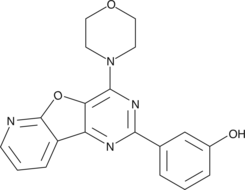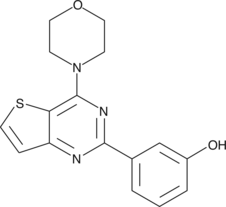Cayman
Showing 35101–35250 of 45550 results
-
Phytanic acid is a saturated 20-carbon branched-chain fatty acid which can only be derived from dietary sources. In cases of peroxisomal disorders, elevated levels of phytanic acid have been observed, and this is linked to diseases such as infantile phytanic acid storage disease and Refsum’s disease.{1912}
Brand:CaymanSKU:90360 - 5 mgAvailable on backorder
Phytanic acid is a saturated 20-carbon branched-chain fatty acid which can only be derived from dietary sources. In cases of peroxisomal disorders, elevated levels of phytanic acid have been observed, and this is linked to diseases such as infantile phytanic acid storage disease and Refsum’s disease.{1912}
Brand:CaymanSKU:90360 - 50 mgAvailable on backorder
Phytanic acid-d3 is intended for use as an internal standard for the quantification of phytanic acid (Item No. 90360) by GC- or LC-MS. Phytanic acid is a saturated 20-carbon branched-chain fatty acid which can only be derived from dietary sources.{1912} In cases of peroxisomal disorders, elevated levels of phytanic acid have been observed, and this is linked to diseases such as infantile phytanic acid storage disease and Refsum’s disease.
Brand:CaymanSKU:29068 - 1 mgAvailable on backorder
Phytanic acid-d3 is intended for use as an internal standard for the quantification of phytanic acid (Item No. 90360) by GC- or LC-MS. Phytanic acid is a saturated 20-carbon branched-chain fatty acid which can only be derived from dietary sources.{1912} In cases of peroxisomal disorders, elevated levels of phytanic acid have been observed, and this is linked to diseases such as infantile phytanic acid storage disease and Refsum’s disease.
Brand:CaymanSKU:29068 - 10 mgAvailable on backorder
Phytanic acid-d3 is intended for use as an internal standard for the quantification of phytanic acid (Item No. 90360) by GC- or LC-MS. Phytanic acid is a saturated 20-carbon branched-chain fatty acid which can only be derived from dietary sources.{1912} In cases of peroxisomal disorders, elevated levels of phytanic acid have been observed, and this is linked to diseases such as infantile phytanic acid storage disease and Refsum’s disease.
Brand:CaymanSKU:29068 - 5 mgAvailable on backorder
Phytol is a diterpene alcohol obtained from the degradation of chlorophyll and has been used in the synthesis of Vitamins E and K. During the digestion process of ruminants, phytol is liberated from chlorophyll and converted to phytanic acid (Item No. 90360) to be stored in fats. While humans cannot derive phytol from chlorophyll, free phytol, obtained from the consumption of ruminant adipose tissue and dairy products, is readily absorbed in the small intestine and converted to phytanic acid.{28384} Phytanic acid accumulates to toxic levels in a number of metabolic disorders, and the conversion of phytol to phytanic acid has been shown to be regulated via the activation of peroxisome proliferator-activated receptor α (PPARα).{28383,28384} Phytol and its metabolites have also been reported to activate retinoid X receptors (RXRs; Kis range from 2.3-67.2 µM) and to promote the activity of PPAR/RXR heterodimers.{28385,28383} Phytol also demonstrates sedative and anxiolytic effects through interaction with the GABAA receptor, and it has been explored as an antischistosomal agent in a mouse model of schistosomiasis.{28381,28382}
Brand:CaymanSKU:-Available on backorder
Phytol is a diterpene alcohol obtained from the degradation of chlorophyll and has been used in the synthesis of Vitamins E and K. During the digestion process of ruminants, phytol is liberated from chlorophyll and converted to phytanic acid (Item No. 90360) to be stored in fats. While humans cannot derive phytol from chlorophyll, free phytol, obtained from the consumption of ruminant adipose tissue and dairy products, is readily absorbed in the small intestine and converted to phytanic acid.{28384} Phytanic acid accumulates to toxic levels in a number of metabolic disorders, and the conversion of phytol to phytanic acid has been shown to be regulated via the activation of peroxisome proliferator-activated receptor α (PPARα).{28383,28384} Phytol and its metabolites have also been reported to activate retinoid X receptors (RXRs; Kis range from 2.3-67.2 µM) and to promote the activity of PPAR/RXR heterodimers.{28385,28383} Phytol also demonstrates sedative and anxiolytic effects through interaction with the GABAA receptor, and it has been explored as an antischistosomal agent in a mouse model of schistosomiasis.{28381,28382}
Brand:CaymanSKU:-Available on backorder
Phytol is a diterpene alcohol obtained from the degradation of chlorophyll and has been used in the synthesis of Vitamins E and K. During the digestion process of ruminants, phytol is liberated from chlorophyll and converted to phytanic acid (Item No. 90360) to be stored in fats. While humans cannot derive phytol from chlorophyll, free phytol, obtained from the consumption of ruminant adipose tissue and dairy products, is readily absorbed in the small intestine and converted to phytanic acid.{28384} Phytanic acid accumulates to toxic levels in a number of metabolic disorders, and the conversion of phytol to phytanic acid has been shown to be regulated via the activation of peroxisome proliferator-activated receptor α (PPARα).{28383,28384} Phytol and its metabolites have also been reported to activate retinoid X receptors (RXRs; Kis range from 2.3-67.2 µM) and to promote the activity of PPAR/RXR heterodimers.{28385,28383} Phytol also demonstrates sedative and anxiolytic effects through interaction with the GABAA receptor, and it has been explored as an antischistosomal agent in a mouse model of schistosomiasis.{28381,28382}
Brand:CaymanSKU:-Available on backorder
Phytol is a diterpene alcohol obtained from the degradation of chlorophyll and has been used in the synthesis of Vitamins E and K. During the digestion process of ruminants, phytol is liberated from chlorophyll and converted to phytanic acid (Item No. 90360) to be stored in fats. While humans cannot derive phytol from chlorophyll, free phytol, obtained from the consumption of ruminant adipose tissue and dairy products, is readily absorbed in the small intestine and converted to phytanic acid.{28384} Phytanic acid accumulates to toxic levels in a number of metabolic disorders, and the conversion of phytol to phytanic acid has been shown to be regulated via the activation of peroxisome proliferator-activated receptor α (PPARα).{28383,28384} Phytol and its metabolites have also been reported to activate retinoid X receptors (RXRs; Kis range from 2.3-67.2 µM) and to promote the activity of PPAR/RXR heterodimers.{28385,28383} Phytol also demonstrates sedative and anxiolytic effects through interaction with the GABAA receptor, and it has been explored as an antischistosomal agent in a mouse model of schistosomiasis.{28381,28382}
Brand:CaymanSKU:-Available on backorder
Phytomonic acid is a saturated fatty acid found mainly in a gram-negative bacteria, L. arabinosus,{16302} but also in protozoa and in the seed oil of B. coccineus (Connaraceae).{16303} Its cyclopropane ring structure has some properties of a double bond, and it may serve to regulate cell membrane fluidity.{16301}
Brand:CaymanSKU:10012556 - 1 mgAvailable on backorder
Phytomonic acid is a saturated fatty acid found mainly in a gram-negative bacteria, L. arabinosus,{16302} but also in protozoa and in the seed oil of B. coccineus (Connaraceae).{16303} Its cyclopropane ring structure has some properties of a double bond, and it may serve to regulate cell membrane fluidity.{16301}
Brand:CaymanSKU:10012556 - 10 mgAvailable on backorder
Phytomonic acid is a saturated fatty acid found mainly in a gram-negative bacteria, L. arabinosus,{16302} but also in protozoa and in the seed oil of B. coccineus (Connaraceae).{16303} Its cyclopropane ring structure has some properties of a double bond, and it may serve to regulate cell membrane fluidity.{16301}
Brand:CaymanSKU:10012556 - 5 mgAvailable on backorder
Phytosphingosine is a sphingolipid with a hydroxyl group at the C4 position that is found mainly in fungi and plants but also in animals, including humans.{39177,39179} It is metabolized to odd-numbered fatty acids with 2-hydroxy palmitic acid (Item No. 22679) as an intermediate.{39084} Phytosphingosine dose-dependently induces cell death of CHO cells and inhibits carbachol-induced activation of phospholipase D (PLD) in CHO cells transfected with C. elegans muscarinic acetylcholine receptors.{39105} It is essential in the heat stress response in S. cerevisiae.{13592} [Matreya, LLC. Catalog No. 1330]
Brand:CaymanSKU:20217 -Available on backorder
Phytosphingosine is a sphingolipid with a hydroxyl group at the C4 position that is found mainly in fungi and plants but also in animals, including humans.{39177,39179} It is metabolized to odd-numbered fatty acids with 2-hydroxy palmitic acid (Item No. 22679) as an intermediate.{39084} Phytosphingosine dose-dependently induces cell death of CHO cells and inhibits carbachol-induced activation of phospholipase D (PLD) in CHO cells transfected with C. elegans muscarinic acetylcholine receptors.{39105} It is essential in the heat stress response in S. cerevisiae.{13592} [Matreya, LLC. Catalog No. 1330]
Brand:CaymanSKU:20217 -Available on backorder
Phytosphingosine is a sphingolipid with a hydroxyl group at the C4 position that is found mainly in fungi and plants but also in animals, including humans.{39177,39179} It is metabolized to odd-numbered fatty acids with 2-hydroxy palmitic acid (Item No. 22679) as an intermediate.{39084} Phytosphingosine dose-dependently induces cell death of CHO cells and inhibits carbachol-induced activation of phospholipase D (PLD) in CHO cells transfected with C. elegans muscarinic acetylcholine receptors.{39105} It is essential in the heat stress response in S. cerevisiae.{13592} [Matreya, LLC. Catalog No. 1330]
Brand:CaymanSKU:20217 -Available on backorder
Phytosphingosine is a sphingolipid with a hydroxyl group at the C4 position that is found mainly in fungi and plants but also in animals, including humans.{39177,39179} It is metabolized to odd-numbered fatty acids with 2-hydroxy palmitic acid (Item No. 22679) as an intermediate.{39084} Phytosphingosine dose-dependently induces cell death of CHO cells and inhibits carbachol-induced activation of phospholipase D (PLD) in CHO cells transfected with C. elegans muscarinic acetylcholine receptors.{39105} It is essential in the heat stress response in S. cerevisiae.{13592} [Matreya, LLC. Catalog No. 1330]
Brand:CaymanSKU:20217 -Available on backorder
The phosphatidylinositol 3-kinases (PI3K) family of enzymes is comprised of 15 members that are divided into 3 classes according to their structure, substrate specificity, and mode of regulation.{14312,14518} PI-103 is a potent, cell-permeable, ATP-competitive inhibitor of phosphatidylinositol 3-kinase (PI3K) family members with selectivity toward DNA-PK, PI3K (p110α), and mTOR. The IC50 values are 2, 8, 20, 26, 48, 83, 88, 150 nM for DNA-PK, p110α, mTORC1, PI3-KC2β, p110δ, mTORC2, p110β, and p110γ, respectively.{14312} PI-103 exhibits antiproliferative activity against a panel of glioma cell lines in vitro at a concentration of 0.5 µM. It also inhibits growth of established human glioma tumor xenografts in vivo with no observable toxicity.{14311}
Brand:CaymanSKU:10009209 - 1 mgAvailable on backorder
The phosphatidylinositol 3-kinases (PI3K) family of enzymes is comprised of 15 members that are divided into 3 classes according to their structure, substrate specificity, and mode of regulation.{14312,14518} PI-103 is a potent, cell-permeable, ATP-competitive inhibitor of phosphatidylinositol 3-kinase (PI3K) family members with selectivity toward DNA-PK, PI3K (p110α), and mTOR. The IC50 values are 2, 8, 20, 26, 48, 83, 88, 150 nM for DNA-PK, p110α, mTORC1, PI3-KC2β, p110δ, mTORC2, p110β, and p110γ, respectively.{14312} PI-103 exhibits antiproliferative activity against a panel of glioma cell lines in vitro at a concentration of 0.5 µM. It also inhibits growth of established human glioma tumor xenografts in vivo with no observable toxicity.{14311}
Brand:CaymanSKU:10009209 - 10 mgAvailable on backorder
The phosphatidylinositol 3-kinases (PI3K) family of enzymes is comprised of 15 members that are divided into 3 classes according to their structure, substrate specificity, and mode of regulation.{14312,14518} PI-103 is a potent, cell-permeable, ATP-competitive inhibitor of phosphatidylinositol 3-kinase (PI3K) family members with selectivity toward DNA-PK, PI3K (p110α), and mTOR. The IC50 values are 2, 8, 20, 26, 48, 83, 88, 150 nM for DNA-PK, p110α, mTORC1, PI3-KC2β, p110δ, mTORC2, p110β, and p110γ, respectively.{14312} PI-103 exhibits antiproliferative activity against a panel of glioma cell lines in vitro at a concentration of 0.5 µM. It also inhibits growth of established human glioma tumor xenografts in vivo with no observable toxicity.{14311}
Brand:CaymanSKU:10009209 - 25 mgAvailable on backorder
The phosphatidylinositol 3-kinases (PI3K) family of enzymes is comprised of 15 members that are divided into 3 classes according to their structure, substrate specificity, and mode of regulation.{14312,14518} PI-103 is a potent, cell-permeable, ATP-competitive inhibitor of phosphatidylinositol 3-kinase (PI3K) family members with selectivity toward DNA-PK, PI3K (p110α), and mTOR. The IC50 values are 2, 8, 20, 26, 48, 83, 88, 150 nM for DNA-PK, p110α, mTORC1, PI3-KC2β, p110δ, mTORC2, p110β, and p110γ, respectively.{14312} PI-103 exhibits antiproliferative activity against a panel of glioma cell lines in vitro at a concentration of 0.5 µM. It also inhibits growth of established human glioma tumor xenografts in vivo with no observable toxicity.{14311}
Brand:CaymanSKU:10009209 - 5 mgAvailable on backorder
PI-103 is a potent, cell-permeable, ATP-competitive inhibitor of PI3K family members with selectivity toward DNA-PK, PI3K (p110α), and mTORC1. The IC50 values are 2, 8, 20, 26, 48, 83, 88, and 150 nM for DNA-PK, p110α, mTORC1, PI3-KC2β, p110δ, mTORC2, p110β, and p110γ, respectively.{14312} PI-103 exhibits antiproliferative activity against a panel of glioma cell lines in vitro at a concentration of 0.5 µM. It also inhibits growth of established human glioma tumor xenografts in vivo with no observable toxicity.{14311}
Brand:CaymanSKU:21187 -Out of stock
PI-103 is a potent, cell-permeable, ATP-competitive inhibitor of PI3K family members with selectivity toward DNA-PK, PI3K (p110α), and mTORC1. The IC50 values are 2, 8, 20, 26, 48, 83, 88, and 150 nM for DNA-PK, p110α, mTORC1, PI3-KC2β, p110δ, mTORC2, p110β, and p110γ, respectively.{14312} PI-103 exhibits antiproliferative activity against a panel of glioma cell lines in vitro at a concentration of 0.5 µM. It also inhibits growth of established human glioma tumor xenografts in vivo with no observable toxicity.{14311}
Brand:CaymanSKU:21187 -Out of stock
PI-103 is a potent, cell-permeable, ATP-competitive inhibitor of PI3K family members with selectivity toward DNA-PK, PI3K (p110α), and mTORC1. The IC50 values are 2, 8, 20, 26, 48, 83, 88, and 150 nM for DNA-PK, p110α, mTORC1, PI3-KC2β, p110δ, mTORC2, p110β, and p110γ, respectively.{14312} PI-103 exhibits antiproliferative activity against a panel of glioma cell lines in vitro at a concentration of 0.5 µM. It also inhibits growth of established human glioma tumor xenografts in vivo with no observable toxicity.{14311}
Brand:CaymanSKU:21187 -Out of stock
PI-103 is a potent, cell-permeable, ATP-competitive inhibitor of PI3K family members with selectivity toward DNA-PK, PI3K (p110α), and mTORC1. The IC50 values are 2, 8, 20, 26, 48, 83, 88, and 150 nM for DNA-PK, p110α, mTORC1, PI3-KC2β, p110δ, mTORC2, p110β, and p110γ, respectively.{14312} PI-103 exhibits antiproliferative activity against a panel of glioma cell lines in vitro at a concentration of 0.5 µM. It also inhibits growth of established human glioma tumor xenografts in vivo with no observable toxicity.{14311}
Brand:CaymanSKU:21187 -Out of stock
PI-3065 is a potent inhibitor of phosphatidylinositol 3-kinase (PI3K) isoform p110δ (IC50 = 15 nM).{32997} It displays greater than 100-fold selectivity for p110δ over p110ɑ, p110β, p110γ, DNA-PK, or mTOR.{32997} PI-3065 suppresses tumor growth and metastasis in mouse xenograft models by inhibiting p110δ activity in regulatory T cells.{32997}
Brand:CaymanSKU:9002394 - 1 mgAvailable on backorder
PI-3065 is a potent inhibitor of phosphatidylinositol 3-kinase (PI3K) isoform p110δ (IC50 = 15 nM).{32997} It displays greater than 100-fold selectivity for p110δ over p110ɑ, p110β, p110γ, DNA-PK, or mTOR.{32997} PI-3065 suppresses tumor growth and metastasis in mouse xenograft models by inhibiting p110δ activity in regulatory T cells.{32997}
Brand:CaymanSKU:9002394 - 10 mgAvailable on backorder
PI-3065 is a potent inhibitor of phosphatidylinositol 3-kinase (PI3K) isoform p110δ (IC50 = 15 nM).{32997} It displays greater than 100-fold selectivity for p110δ over p110ɑ, p110β, p110γ, DNA-PK, or mTOR.{32997} PI-3065 suppresses tumor growth and metastasis in mouse xenograft models by inhibiting p110δ activity in regulatory T cells.{32997}
Brand:CaymanSKU:9002394 - 25 mgAvailable on backorder
PI-3065 is a potent inhibitor of phosphatidylinositol 3-kinase (PI3K) isoform p110δ (IC50 = 15 nM).{32997} It displays greater than 100-fold selectivity for p110δ over p110ɑ, p110β, p110γ, DNA-PK, or mTOR.{32997} PI-3065 suppresses tumor growth and metastasis in mouse xenograft models by inhibiting p110δ activity in regulatory T cells.{32997}
Brand:CaymanSKU:9002394 - 5 mgAvailable on backorder
PI-828 is a potent inhibitor of phosphatidylinositol 3-kinase (PI3K; IC50s = 9.8, 183, 227, and 1,967 nM for p110β, p110α, p110δ, and p110γ, respectively).{38012} This molecule has been immobilized on epoxy-containing solid surface via the 4’amine for binding studies and shown to interact with non-PI3K cellular proteins such as mTOR, ALDH1, BRD4, CKIIα, and GSK-3β.
Brand:CaymanSKU:21811 -Out of stock
PI-828 is a potent inhibitor of phosphatidylinositol 3-kinase (PI3K; IC50s = 9.8, 183, 227, and 1,967 nM for p110β, p110α, p110δ, and p110γ, respectively).{38012} This molecule has been immobilized on epoxy-containing solid surface via the 4’amine for binding studies and shown to interact with non-PI3K cellular proteins such as mTOR, ALDH1, BRD4, CKIIα, and GSK-3β.
Brand:CaymanSKU:21811 -Out of stock
PI-828 is a potent inhibitor of phosphatidylinositol 3-kinase (PI3K; IC50s = 9.8, 183, 227, and 1,967 nM for p110β, p110α, p110δ, and p110γ, respectively).{38012} This molecule has been immobilized on epoxy-containing solid surface via the 4’amine for binding studies and shown to interact with non-PI3K cellular proteins such as mTOR, ALDH1, BRD4, CKIIα, and GSK-3β.
Brand:CaymanSKU:21811 -Out of stock
PI3-Kinase α (PI3Kα) inhibitor 2 is an inhibitor of PI3K p110α (IC50 = 2 nM in an enzyme assay).{14907} It is selective for p110α over p110β, p110γ, and PI3K C2β (IC50s = 16, 660, and 220 nM, respectively). It also inhibits mammalian target of rapamycin (mTOR; IC50 = 49 nM).{42914} PI3Kα inhibitor 2 inhibits proliferation in A375 melanoma cells with an IC50 value of 0.58 μM.{14907}
Brand:CaymanSKU:10010177 - 1 mgAvailable on backorder
PI3-Kinase α (PI3Kα) inhibitor 2 is an inhibitor of PI3K p110α (IC50 = 2 nM in an enzyme assay).{14907} It is selective for p110α over p110β, p110γ, and PI3K C2β (IC50s = 16, 660, and 220 nM, respectively). It also inhibits mammalian target of rapamycin (mTOR; IC50 = 49 nM).{42914} PI3Kα inhibitor 2 inhibits proliferation in A375 melanoma cells with an IC50 value of 0.58 μM.{14907}
Brand:CaymanSKU:10010177 - 10 mgAvailable on backorder
PI3-Kinase α (PI3Kα) inhibitor 2 is an inhibitor of PI3K p110α (IC50 = 2 nM in an enzyme assay).{14907} It is selective for p110α over p110β, p110γ, and PI3K C2β (IC50s = 16, 660, and 220 nM, respectively). It also inhibits mammalian target of rapamycin (mTOR; IC50 = 49 nM).{42914} PI3Kα inhibitor 2 inhibits proliferation in A375 melanoma cells with an IC50 value of 0.58 μM.{14907}
Brand:CaymanSKU:10010177 - 5 mgAvailable on backorder
PI3-Kinase α (PI3Kα) inhibitor 2 is an inhibitor of PI3K p110α (IC50 = 2 nM in an enzyme assay).{14907} It is selective for p110α over p110β, p110γ, and PI3K C2β (IC50s = 16, 660, and 220 nM, respectively). It also inhibits mammalian target of rapamycin (mTOR; IC50 = 49 nM).{42914} PI3Kα inhibitor 2 inhibits proliferation in A375 melanoma cells with an IC50 value of 0.58 μM.{14907}
Brand:CaymanSKU:-PI3-Kinase α (PI3Kα) inhibitor 2 is an inhibitor of PI3K p110α (IC50 = 2 nM in an enzyme assay).{14907} It is selective for p110α over p110β, p110γ, and PI3K C2β (IC50s = 16, 660, and 220 nM, respectively). It also inhibits mammalian target of rapamycin (mTOR; IC50 = 49 nM).{42914} PI3Kα inhibitor 2 inhibits proliferation in A375 melanoma cells with an IC50 value of 0.58 μM.{14907}
Brand:CaymanSKU:10010177 - 500 µgAvailable on backorder
PI3-Kinase α (PI3Kα) inhibitor 2 is an inhibitor of PI3K p110α (IC50 = 2 nM in an enzyme assay).{14907} It is selective for p110α over p110β, p110γ, and PI3K C2β (IC50s = 16, 660, and 220 nM, respectively). It also inhibits mammalian target of rapamycin (mTOR; IC50 = 49 nM).{42914} PI3Kα inhibitor 2 inhibits proliferation in A375 melanoma cells with an IC50 value of 0.58 μM.{14907}
Brand:CaymanSKU:21197 -Out of stock
PI3-Kinase α (PI3Kα) inhibitor 2 is an inhibitor of PI3K p110α (IC50 = 2 nM in an enzyme assay).{14907} It is selective for p110α over p110β, p110γ, and PI3K C2β (IC50s = 16, 660, and 220 nM, respectively). It also inhibits mammalian target of rapamycin (mTOR; IC50 = 49 nM).{42914} PI3Kα inhibitor 2 inhibits proliferation in A375 melanoma cells with an IC50 value of 0.58 μM.{14907}
Brand:CaymanSKU:21197 -Out of stock
PI3-Kinase α (PI3Kα) inhibitor 2 is an inhibitor of PI3K p110α (IC50 = 2 nM in an enzyme assay).{14907} It is selective for p110α over p110β, p110γ, and PI3K C2β (IC50s = 16, 660, and 220 nM, respectively). It also inhibits mammalian target of rapamycin (mTOR; IC50 = 49 nM).{42914} PI3Kα inhibitor 2 inhibits proliferation in A375 melanoma cells with an IC50 value of 0.58 μM.{14907}
Brand:CaymanSKU:21197 -Out of stock
Pibrentasvir is an inhibitor of hepatitis C virus (HCV) non-structural protein 5A (NS5A).{51095} It inhibits HCV replication in stable replicon cell lines containing NS5A from genotypes 1-6 (EC50s = 1.4-4.3 pM). Pibrentasvir acts synergistically with the HCV NS3/4A protease inhibitor glecaprevir to inhibit HCV genotype 1b-Con1 replication in replicon cells.{51096} Formulations containing pibrentasvir have been used in combination with glecaprevir in the treatment of HCV infection.
Brand:CaymanSKU:27546 - 1 mgAvailable on backorder
Pibrentasvir is an inhibitor of hepatitis C virus (HCV) non-structural protein 5A (NS5A).{51095} It inhibits HCV replication in stable replicon cell lines containing NS5A from genotypes 1-6 (EC50s = 1.4-4.3 pM). Pibrentasvir acts synergistically with the HCV NS3/4A protease inhibitor glecaprevir to inhibit HCV genotype 1b-Con1 replication in replicon cells.{51096} Formulations containing pibrentasvir have been used in combination with glecaprevir in the treatment of HCV infection.
Brand:CaymanSKU:27546 - 10 mgAvailable on backorder
Pibrentasvir is an inhibitor of hepatitis C virus (HCV) non-structural protein 5A (NS5A).{51095} It inhibits HCV replication in stable replicon cell lines containing NS5A from genotypes 1-6 (EC50s = 1.4-4.3 pM). Pibrentasvir acts synergistically with the HCV NS3/4A protease inhibitor glecaprevir to inhibit HCV genotype 1b-Con1 replication in replicon cells.{51096} Formulations containing pibrentasvir have been used in combination with glecaprevir in the treatment of HCV infection.
Brand:CaymanSKU:27546 - 25 mgAvailable on backorder
Pibrentasvir is an inhibitor of hepatitis C virus (HCV) non-structural protein 5A (NS5A).{51095} It inhibits HCV replication in stable replicon cell lines containing NS5A from genotypes 1-6 (EC50s = 1.4-4.3 pM). Pibrentasvir acts synergistically with the HCV NS3/4A protease inhibitor glecaprevir to inhibit HCV genotype 1b-Con1 replication in replicon cells.{51096} Formulations containing pibrentasvir have been used in combination with glecaprevir in the treatment of HCV infection.
Brand:CaymanSKU:27546 - 5 mgAvailable on backorder
Picamilon is a derivative of γ-aminobutyric acid (GABA).{53429} It increases parietal cortical blood flow in rats and rabbits when administered at doses of 50 mg/kg, i.p. and 10 mg/kg, i.v., respectively.{53430} Picamilon (10 mg/kg) increases latency to enter the dark compartment in the passive avoidance conditioned reflex test in rats compared with control animals, indicating nootropic effects.{53429}
Brand:CaymanSKU:29397 - 1 gAvailable on backorder
Picamilon is a derivative of γ-aminobutyric acid (GABA).{53429} It increases parietal cortical blood flow in rats and rabbits when administered at doses of 50 mg/kg, i.p. and 10 mg/kg, i.v., respectively.{53430} Picamilon (10 mg/kg) increases latency to enter the dark compartment in the passive avoidance conditioned reflex test in rats compared with control animals, indicating nootropic effects.{53429}
Brand:CaymanSKU:29397 - 100 mgAvailable on backorder
Picamilon is a derivative of γ-aminobutyric acid (GABA).{53429} It increases parietal cortical blood flow in rats and rabbits when administered at doses of 50 mg/kg, i.p. and 10 mg/kg, i.v., respectively.{53430} Picamilon (10 mg/kg) increases latency to enter the dark compartment in the passive avoidance conditioned reflex test in rats compared with control animals, indicating nootropic effects.{53429}
Brand:CaymanSKU:29397 - 250 mgAvailable on backorder
Picamilon is a derivative of γ-aminobutyric acid (GABA).{53429} It increases parietal cortical blood flow in rats and rabbits when administered at doses of 50 mg/kg, i.p. and 10 mg/kg, i.v., respectively.{53430} Picamilon (10 mg/kg) increases latency to enter the dark compartment in the passive avoidance conditioned reflex test in rats compared with control animals, indicating nootropic effects.{53429}
Brand:CaymanSKU:29397 - 500 mgAvailable on backorder
Picaridin is an insect repellent that is effective against a range of arthropods, including mosquitoes and ticks.{27049,27048} It shows synergy with the non-pyrethroid insecticide propoxur both in killing and repelling mosquitoes.{27047} Picaridin and other insect repellents have been shown to act as either agonists or antagonists at insect olfactory receptors.{27045,27046}
Brand:CaymanSKU:-Out of stock
Resveratrol is a potent phenolic antioxidant found in the skin of grapes and red wine that has anti-proliferative, anti-inflammatory, and cardioprotective properties.{9146} Piceatannol is a resveratrol analog formed by the cytochrome P450-catalyzed hydroxylation of resveratrol.{15736} Piceatannol exhibits potent anticancer properties by inducing apoptosis in BJAB Burkitt-like lymphoma cells with an ED50 value of 25 µM.{15733} Piceatannol also exhibits anti-proliferative and anti-inflammatory effects by inhibiting the activity of a wide range of tyrosine and serine/threonine protein kinases and suppressing NF-κB activation through inhibition of IκBα kinase.{15735,15734}
Brand:CaymanSKU:10009366 - 10 mgAvailable on backorder
Resveratrol is a potent phenolic antioxidant found in the skin of grapes and red wine that has anti-proliferative, anti-inflammatory, and cardioprotective properties.{9146} Piceatannol is a resveratrol analog formed by the cytochrome P450-catalyzed hydroxylation of resveratrol.{15736} Piceatannol exhibits potent anticancer properties by inducing apoptosis in BJAB Burkitt-like lymphoma cells with an ED50 value of 25 µM.{15733} Piceatannol also exhibits anti-proliferative and anti-inflammatory effects by inhibiting the activity of a wide range of tyrosine and serine/threonine protein kinases and suppressing NF-κB activation through inhibition of IκBα kinase.{15735,15734}
Brand:CaymanSKU:10009366 - 25 mgAvailable on backorder
Resveratrol is a potent phenolic antioxidant found in the skin of grapes and red wine that has anti-proliferative, anti-inflammatory, and cardioprotective properties.{9146} Piceatannol is a resveratrol analog formed by the cytochrome P450-catalyzed hydroxylation of resveratrol.{15736} Piceatannol exhibits potent anticancer properties by inducing apoptosis in BJAB Burkitt-like lymphoma cells with an ED50 value of 25 µM.{15733} Piceatannol also exhibits anti-proliferative and anti-inflammatory effects by inhibiting the activity of a wide range of tyrosine and serine/threonine protein kinases and suppressing NF-κB activation through inhibition of IκBα kinase.{15735,15734}
Brand:CaymanSKU:10009366 - 5 mgAvailable on backorder
Resveratrol is a potent phenolic antioxidant found in the skin of grapes and red wine that has anti-proliferative, anti-inflammatory, and cardioprotective properties.{9146} Piceatannol is a resveratrol analog formed by the cytochrome P450-catalyzed hydroxylation of resveratrol.{15736} Piceatannol exhibits potent anticancer properties by inducing apoptosis in BJAB Burkitt-like lymphoma cells with an ED50 value of 25 µM.{15733} Piceatannol also exhibits anti-proliferative and anti-inflammatory effects by inhibiting the activity of a wide range of tyrosine and serine/threonine protein kinases and suppressing NF-κB activation through inhibition of IκBα kinase.{15735,15734}
Brand:CaymanSKU:10009366 - 50 mgAvailable on backorder
Piclamilast is a phosphodiesterase 4 (PDE4) inhibitor (IC50 = 0.31 nM).{52090} It is selective for PDE4 over PDE1, PDE2, PDE3, PDE5, and PDE7A in cell-free assays (IC50s = >100, 40, >100, 14, and >10 μM, respectively).{52091,52089} Piclamilast inhibits superoxide production by guinea pig eosinophils and histamine-induced contraction in isolated guinea pig trachea (IC50s = 24 and 2 nM, respectively).{52090,52088} It inhibits eosinophil, neutrophil, lymphocyte, and TNF-α accumulation in bronchoalveolar lavage fluid (BALF) from ovalbumin-sensitized rats (ED50s = 23.8, 14.1, 19.5, and 14.4 μmol/kg, respectively).{52087} Piclamilast also inhibits ovalbumin-induced bronchoconstriction in a guinea pig model of asthma (ED50 = 0.033 mg/kg).{52091}
Brand:CaymanSKU:29170 - 1 mgAvailable on backorder
Piclamilast is a phosphodiesterase 4 (PDE4) inhibitor (IC50 = 0.31 nM).{52090} It is selective for PDE4 over PDE1, PDE2, PDE3, PDE5, and PDE7A in cell-free assays (IC50s = >100, 40, >100, 14, and >10 μM, respectively).{52091,52089} Piclamilast inhibits superoxide production by guinea pig eosinophils and histamine-induced contraction in isolated guinea pig trachea (IC50s = 24 and 2 nM, respectively).{52090,52088} It inhibits eosinophil, neutrophil, lymphocyte, and TNF-α accumulation in bronchoalveolar lavage fluid (BALF) from ovalbumin-sensitized rats (ED50s = 23.8, 14.1, 19.5, and 14.4 μmol/kg, respectively).{52087} Piclamilast also inhibits ovalbumin-induced bronchoconstriction in a guinea pig model of asthma (ED50 = 0.033 mg/kg).{52091}
Brand:CaymanSKU:29170 - 10 mgAvailable on backorder
Piclamilast is a phosphodiesterase 4 (PDE4) inhibitor (IC50 = 0.31 nM).{52090} It is selective for PDE4 over PDE1, PDE2, PDE3, PDE5, and PDE7A in cell-free assays (IC50s = >100, 40, >100, 14, and >10 μM, respectively).{52091,52089} Piclamilast inhibits superoxide production by guinea pig eosinophils and histamine-induced contraction in isolated guinea pig trachea (IC50s = 24 and 2 nM, respectively).{52090,52088} It inhibits eosinophil, neutrophil, lymphocyte, and TNF-α accumulation in bronchoalveolar lavage fluid (BALF) from ovalbumin-sensitized rats (ED50s = 23.8, 14.1, 19.5, and 14.4 μmol/kg, respectively).{52087} Piclamilast also inhibits ovalbumin-induced bronchoconstriction in a guinea pig model of asthma (ED50 = 0.033 mg/kg).{52091}
Brand:CaymanSKU:29170 - 5 mgAvailable on backorder
Piclidenoson is an adenosine A3 receptor agonist (Ki = 1.7 nM).{52557} It is selective for adenosine A3 over A1 and A2 receptors (Kis = 55.3 and 3,099 nM, respectively). In vivo, piclidenoson (100 µg/kg) reduces wall thickening in a rabbit model of ischemia-reperfusion injury induced by coronary artery occlusion, an effect that can be reversed by the adenosine receptor antagonist 8-p-sulfophenyl theophylline.{52556} It reduces hepatocellular tumor growth, liver inflammation, and neuropathy in a rat model of bone-residing breast cancer and decreases the number of lung metastases in a model of metastatic murine melanoma.{52557} Piclidenoson (1 and 3 mg/kg) also reduces colonic inflammatory cell infiltration and damage in a mouse model of colitis induced by dextran sulfate (DSS; Item No. 23250) and in IL-10-/- mice.{52558}
Brand:CaymanSKU:28445 - 1 mgAvailable on backorder
Piclidenoson is an adenosine A3 receptor agonist (Ki = 1.7 nM).{52557} It is selective for adenosine A3 over A1 and A2 receptors (Kis = 55.3 and 3,099 nM, respectively). In vivo, piclidenoson (100 µg/kg) reduces wall thickening in a rabbit model of ischemia-reperfusion injury induced by coronary artery occlusion, an effect that can be reversed by the adenosine receptor antagonist 8-p-sulfophenyl theophylline.{52556} It reduces hepatocellular tumor growth, liver inflammation, and neuropathy in a rat model of bone-residing breast cancer and decreases the number of lung metastases in a model of metastatic murine melanoma.{52557} Piclidenoson (1 and 3 mg/kg) also reduces colonic inflammatory cell infiltration and damage in a mouse model of colitis induced by dextran sulfate (DSS; Item No. 23250) and in IL-10-/- mice.{52558}
Brand:CaymanSKU:28445 - 10 mgAvailable on backorder
Piclidenoson is an adenosine A3 receptor agonist (Ki = 1.7 nM).{52557} It is selective for adenosine A3 over A1 and A2 receptors (Kis = 55.3 and 3,099 nM, respectively). In vivo, piclidenoson (100 µg/kg) reduces wall thickening in a rabbit model of ischemia-reperfusion injury induced by coronary artery occlusion, an effect that can be reversed by the adenosine receptor antagonist 8-p-sulfophenyl theophylline.{52556} It reduces hepatocellular tumor growth, liver inflammation, and neuropathy in a rat model of bone-residing breast cancer and decreases the number of lung metastases in a model of metastatic murine melanoma.{52557} Piclidenoson (1 and 3 mg/kg) also reduces colonic inflammatory cell infiltration and damage in a mouse model of colitis induced by dextran sulfate (DSS; Item No. 23250) and in IL-10-/- mice.{52558}
Brand:CaymanSKU:28445 - 25 mgAvailable on backorder
Piclidenoson is an adenosine A3 receptor agonist (Ki = 1.7 nM).{52557} It is selective for adenosine A3 over A1 and A2 receptors (Kis = 55.3 and 3,099 nM, respectively). In vivo, piclidenoson (100 µg/kg) reduces wall thickening in a rabbit model of ischemia-reperfusion injury induced by coronary artery occlusion, an effect that can be reversed by the adenosine receptor antagonist 8-p-sulfophenyl theophylline.{52556} It reduces hepatocellular tumor growth, liver inflammation, and neuropathy in a rat model of bone-residing breast cancer and decreases the number of lung metastases in a model of metastatic murine melanoma.{52557} Piclidenoson (1 and 3 mg/kg) also reduces colonic inflammatory cell infiltration and damage in a mouse model of colitis induced by dextran sulfate (DSS; Item No. 23250) and in IL-10-/- mice.{52558}
Brand:CaymanSKU:28445 - 5 mgAvailable on backorder
Picotamide is an antiplatelet drug that inhibits both thromboxane A2 (TXA2) receptors (Kd = 325 nM) and TXA2 synthase.{34208,34210} It significantly inhibits basal and lipopolysaccharide-stimulated TXA2 synthesis by rat peritoneal macrophages when used at 0.5 mM.{34209} Formulations containing picotamide have potential applications in the reduction of peripheral artery disease in patients with diabetes.{34208}
Brand:CaymanSKU:21690 -Out of stock
Picotamide is an antiplatelet drug that inhibits both thromboxane A2 (TXA2) receptors (Kd = 325 nM) and TXA2 synthase.{34208,34210} It significantly inhibits basal and lipopolysaccharide-stimulated TXA2 synthesis by rat peritoneal macrophages when used at 0.5 mM.{34209} Formulations containing picotamide have potential applications in the reduction of peripheral artery disease in patients with diabetes.{34208}
Brand:CaymanSKU:21690 -Out of stock
Picotamide is an antiplatelet drug that inhibits both thromboxane A2 (TXA2) receptors (Kd = 325 nM) and TXA2 synthase.{34208,34210} It significantly inhibits basal and lipopolysaccharide-stimulated TXA2 synthesis by rat peritoneal macrophages when used at 0.5 mM.{34209} Formulations containing picotamide have potential applications in the reduction of peripheral artery disease in patients with diabetes.{34208}
Brand:CaymanSKU:21690 -Out of stock
Picotamide is an antiplatelet drug that inhibits both thromboxane A2 (TXA2) receptors (Kd = 325 nM) and TXA2 synthase.{34208,34210} It significantly inhibits basal and lipopolysaccharide-stimulated TXA2 synthesis by rat peritoneal macrophages when used at 0.5 mM.{34209} Formulations containing picotamide have potential applications in the reduction of peripheral artery disease in patients with diabetes.{34208}
Brand:CaymanSKU:21690 -Out of stock
Picropodophyllotoxin (PPP) is a potent and selective inhibitor of the insulin-like growth factor-1 receptor (IGF-1R), blocking the phosphorylation of artificial substrates with an IC50 value of 6 nM.{33633} It does not block substrate phosphorylation by insulin receptor, EGFR, FGFR, or PDGFR. PPP inhibits IGF-1R autophosphorylation (IC50 = ~1 nM), causes cell cycle arrest in G2/M phase, and induces apoptosis.{33633,33634} It is orally active and causes complete tumor regression in xenografted and allografted mice.{33633} Presumably through its effect on IGF-1R, PPP reduces VEGF expression and suppresses choroidal neovascularization in vivo.{33631}
Brand:CaymanSKU:-Available on backorder
Picropodophyllotoxin (PPP) is a potent and selective inhibitor of the insulin-like growth factor-1 receptor (IGF-1R), blocking the phosphorylation of artificial substrates with an IC50 value of 6 nM.{33633} It does not block substrate phosphorylation by insulin receptor, EGFR, FGFR, or PDGFR. PPP inhibits IGF-1R autophosphorylation (IC50 = ~1 nM), causes cell cycle arrest in G2/M phase, and induces apoptosis.{33633,33634} It is orally active and causes complete tumor regression in xenografted and allografted mice.{33633} Presumably through its effect on IGF-1R, PPP reduces VEGF expression and suppresses choroidal neovascularization in vivo.{33631}
Brand:CaymanSKU:-Available on backorder
Picropodophyllotoxin (PPP) is a potent and selective inhibitor of the insulin-like growth factor-1 receptor (IGF-1R), blocking the phosphorylation of artificial substrates with an IC50 value of 6 nM.{33633} It does not block substrate phosphorylation by insulin receptor, EGFR, FGFR, or PDGFR. PPP inhibits IGF-1R autophosphorylation (IC50 = ~1 nM), causes cell cycle arrest in G2/M phase, and induces apoptosis.{33633,33634} It is orally active and causes complete tumor regression in xenografted and allografted mice.{33633} Presumably through its effect on IGF-1R, PPP reduces VEGF expression and suppresses choroidal neovascularization in vivo.{33631}
Brand:CaymanSKU:-Available on backorder
Picropodophyllotoxin (PPP) is a potent and selective inhibitor of the insulin-like growth factor-1 receptor (IGF-1R), blocking the phosphorylation of artificial substrates with an IC50 value of 6 nM.{33633} It does not block substrate phosphorylation by insulin receptor, EGFR, FGFR, or PDGFR. PPP inhibits IGF-1R autophosphorylation (IC50 = ~1 nM), causes cell cycle arrest in G2/M phase, and induces apoptosis.{33633,33634} It is orally active and causes complete tumor regression in xenografted and allografted mice.{33633} Presumably through its effect on IGF-1R, PPP reduces VEGF expression and suppresses choroidal neovascularization in vivo.{33631}
Brand:CaymanSKU:-Available on backorder
Picroliv is a hepatoprotective mixture of compounds that is isolated from an herb native to the Himalayas.{18586} Picroside I is an iridoid glycoside found in picroliv.{18586} By itself, picroside I blocks changes in acid phosphatase activity, phospholipid levels, and lipid peroxide production induced by D-galactosamine in rat liver.{25374} Picroside I also enhances neurite outgrowth in PC12D cells induced by basic fibroblast growth factor and 7S nerve growth factor when given at 60 μM.{25371,25372} At concentrations as low as 5 μM, picroside I enhances the ATPase activity of the efflux transporter P-glycoprotein.{25373}
Brand:CaymanSKU:-Picroliv is a hepatoprotective mixture of compounds that is isolated from an herb native to the Himalayas.{18586} Picroside I is an iridoid glycoside found in picroliv.{18586} By itself, picroside I blocks changes in acid phosphatase activity, phospholipid levels, and lipid peroxide production induced by D-galactosamine in rat liver.{25374} Picroside I also enhances neurite outgrowth in PC12D cells induced by basic fibroblast growth factor and 7S nerve growth factor when given at 60 μM.{25371,25372} At concentrations as low as 5 μM, picroside I enhances the ATPase activity of the efflux transporter P-glycoprotein.{25373}
Brand:CaymanSKU:-Picroliv is a hepatoprotective mixture of compounds that is isolated from an herb native to the Himalayas.{18586} Picroside I is an iridoid glycoside found in picroliv.{18586} By itself, picroside I blocks changes in acid phosphatase activity, phospholipid levels, and lipid peroxide production induced by D-galactosamine in rat liver.{25374} Picroside I also enhances neurite outgrowth in PC12D cells induced by basic fibroblast growth factor and 7S nerve growth factor when given at 60 μM.{25371,25372} At concentrations as low as 5 μM, picroside I enhances the ATPase activity of the efflux transporter P-glycoprotein.{25373}
Brand:CaymanSKU:-Picroliv is a hepatoprotective mixture of compounds that is isolated from an herb native to the Himalayas.{18586} Picroside I is an iridoid glycoside found in picroliv.{18586} By itself, picroside I blocks changes in acid phosphatase activity, phospholipid levels, and lipid peroxide production induced by D-galactosamine in rat liver.{25374} Picroside I also enhances neurite outgrowth in PC12D cells induced by basic fibroblast growth factor and 7S nerve growth factor when given at 60 μM.{25371,25372} At concentrations as low as 5 μM, picroside I enhances the ATPase activity of the efflux transporter P-glycoprotein.{25373}
Brand:CaymanSKU:-Picroside II is a flavonoid that has been isolated from P. kurroa and has diverse biological activities.{52489,52490,52491,52492} It decreases expression of FATP5 and SCD, encoding fatty acid transport protein 5 and steroyl CoA desaturase, respectively, and inhibits free fatty acid-induced lipid accumulation in HepG2 cells when used at a concentration of 10 µM.{52489} Picroside II inhibits RANKL-induced osteoclast formation in isolated murine bone marrow cells and decreases the size of bone resorption pits in bovine bone slices.{52490} In vivo, picroside II (10 and 60 mg/kg) inhibits LPS-induced trabecular bone loss in a mouse model of inflammatory osteoporosis. It prevents ischemia-reperfusion-induced testicular apoptosis and malondialdehyde (MDA) production in a rat model of testicular torsion.{52491} Picroside II also reduces airway inflammation, lung mucus hypersecretion, and bronchoalveolar lavage fluid (BALF) inflammatory cell infiltration in a mouse model of house dust mite-induced allergic asthma.{52492}
Brand:CaymanSKU:30319 - 10 mgAvailable on backorder
Picroside II is a flavonoid that has been isolated from P. kurroa and has diverse biological activities.{52489,52490,52491,52492} It decreases expression of FATP5 and SCD, encoding fatty acid transport protein 5 and steroyl CoA desaturase, respectively, and inhibits free fatty acid-induced lipid accumulation in HepG2 cells when used at a concentration of 10 µM.{52489} Picroside II inhibits RANKL-induced osteoclast formation in isolated murine bone marrow cells and decreases the size of bone resorption pits in bovine bone slices.{52490} In vivo, picroside II (10 and 60 mg/kg) inhibits LPS-induced trabecular bone loss in a mouse model of inflammatory osteoporosis. It prevents ischemia-reperfusion-induced testicular apoptosis and malondialdehyde (MDA) production in a rat model of testicular torsion.{52491} Picroside II also reduces airway inflammation, lung mucus hypersecretion, and bronchoalveolar lavage fluid (BALF) inflammatory cell infiltration in a mouse model of house dust mite-induced allergic asthma.{52492}
Brand:CaymanSKU:30319 - 100 mgAvailable on backorder
Picroside II is a flavonoid that has been isolated from P. kurroa and has diverse biological activities.{52489,52490,52491,52492} It decreases expression of FATP5 and SCD, encoding fatty acid transport protein 5 and steroyl CoA desaturase, respectively, and inhibits free fatty acid-induced lipid accumulation in HepG2 cells when used at a concentration of 10 µM.{52489} Picroside II inhibits RANKL-induced osteoclast formation in isolated murine bone marrow cells and decreases the size of bone resorption pits in bovine bone slices.{52490} In vivo, picroside II (10 and 60 mg/kg) inhibits LPS-induced trabecular bone loss in a mouse model of inflammatory osteoporosis. It prevents ischemia-reperfusion-induced testicular apoptosis and malondialdehyde (MDA) production in a rat model of testicular torsion.{52491} Picroside II also reduces airway inflammation, lung mucus hypersecretion, and bronchoalveolar lavage fluid (BALF) inflammatory cell infiltration in a mouse model of house dust mite-induced allergic asthma.{52492}
Brand:CaymanSKU:30319 - 250 mgAvailable on backorder
Picroside II is a flavonoid that has been isolated from P. kurroa and has diverse biological activities.{52489,52490,52491,52492} It decreases expression of FATP5 and SCD, encoding fatty acid transport protein 5 and steroyl CoA desaturase, respectively, and inhibits free fatty acid-induced lipid accumulation in HepG2 cells when used at a concentration of 10 µM.{52489} Picroside II inhibits RANKL-induced osteoclast formation in isolated murine bone marrow cells and decreases the size of bone resorption pits in bovine bone slices.{52490} In vivo, picroside II (10 and 60 mg/kg) inhibits LPS-induced trabecular bone loss in a mouse model of inflammatory osteoporosis. It prevents ischemia-reperfusion-induced testicular apoptosis and malondialdehyde (MDA) production in a rat model of testicular torsion.{52491} Picroside II also reduces airway inflammation, lung mucus hypersecretion, and bronchoalveolar lavage fluid (BALF) inflammatory cell infiltration in a mouse model of house dust mite-induced allergic asthma.{52492}
Brand:CaymanSKU:30319 - 50 mgAvailable on backorder
Picrotin is a natural picrotoxane that antagonizes glycine receptors (GlyRs; IC50s = 57 and 117 µM for α1 and α2 homodimeric GlyRs, respectively).{33999,42440} It also inhibits α3 homodimeric GlyRs.{34001} Picrotin is inactive in inhibiting γ-aminobutyric acid (GABA) type A and type C receptors. Picrotin occurs in the natural plant-derived poison picrotoxin (Item No. 20771), equimolar with picrotoxinin.
Brand:CaymanSKU:21870 -Out of stock
Picrotin is a natural picrotoxane that antagonizes glycine receptors (GlyRs; IC50s = 57 and 117 µM for α1 and α2 homodimeric GlyRs, respectively).{33999,42440} It also inhibits α3 homodimeric GlyRs.{34001} Picrotin is inactive in inhibiting γ-aminobutyric acid (GABA) type A and type C receptors. Picrotin occurs in the natural plant-derived poison picrotoxin (Item No. 20771), equimolar with picrotoxinin.
Brand:CaymanSKU:21870 -Out of stock
Picrotin is a natural picrotoxane that antagonizes glycine receptors (GlyRs; IC50s = 57 and 117 µM for α1 and α2 homodimeric GlyRs, respectively).{33999,42440} It also inhibits α3 homodimeric GlyRs.{34001} Picrotin is inactive in inhibiting γ-aminobutyric acid (GABA) type A and type C receptors. Picrotin occurs in the natural plant-derived poison picrotoxin (Item No. 20771), equimolar with picrotoxinin.
Brand:CaymanSKU:21870 -Out of stock
Picrotin is a natural picrotoxane that antagonizes glycine receptors (GlyRs; IC50s = 57 and 117 µM for α1 and α2 homodimeric GlyRs, respectively).{33999,42440} It also inhibits α3 homodimeric GlyRs.{34001} Picrotin is inactive in inhibiting γ-aminobutyric acid (GABA) type A and type C receptors. Picrotin occurs in the natural plant-derived poison picrotoxin (Item No. 20771), equimolar with picrotoxinin.
Brand:CaymanSKU:21870 -Out of stock
Picrotoxin is a natural plant-derived poison that acts as a selective GABAA receptor antagonist.{32532,32535} It is functional in vivo and is used to study the role of GABAA receptors in the central nervous system as well in the periphery.{32533,32534} Picrotoxin induces seizures in adult and immature animals and is used to study GABAA-dependent seizures and drugs that block this pathway.{32536}
Brand:CaymanSKU:20771 -Available on backorder
Picrotoxin is a natural plant-derived poison that acts as a selective GABAA receptor antagonist.{32532,32535} It is functional in vivo and is used to study the role of GABAA receptors in the central nervous system as well in the periphery.{32533,32534} Picrotoxin induces seizures in adult and immature animals and is used to study GABAA-dependent seizures and drugs that block this pathway.{32536}
Brand:CaymanSKU:20771 -Available on backorder






















